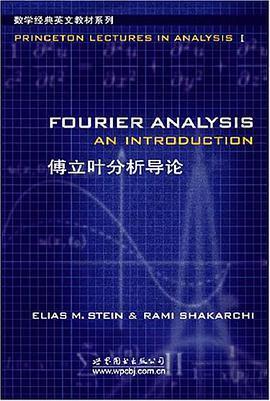注重体验与质量的电子书资源下载网站
分类于: 云计算&大数据 互联网
简介

傅立叶分析导论: An Introduction (Princeton Lectures in Analysis, Volume 1) 豆 9.3分
资源最后更新于 2020-10-05 18:46:37
作者:Elias M. Stein
出版社:世界图书出版公司(此信息作废)
出版日期:2006-01
ISBN:9787506272872
文件格式: pdf
标签: 数学 傅立叶分析 分析 Elias.M.Stein 数学经典教材 Fourier Analysis 分析学
简介· · · · · ·
《傅立叶分析导论》分为3部分:第1部分介绍傅立叶级数的基本理论及其在等周不等式和等分布中的应用;第2部分研究傅立叶变换及其在经典偏微分方程及Radom变换中的应用;第3部分研究有限阿贝尔群上的傅立叶分析。书中各章均有练习题及思考题。
目录
foreword
preface
chapter 1. the genesis of fourier analysis
1 the vibrating string
1.1 derivation of the wave equation
1.2 solution to the wave equation
1.3 example: the plucked string
2 the heat equation
2.1 derivation of the heat equation
2.2 steady-state heat equation in the disc
3 exercises
4 problem
chapter 2. basic properties of fourier series
1 examples and formulation of the problem
1.1 main definitions and some examples
2 uniqueness of fourier series
3 convolutions
4 good kernels
5 cesaro and abel summability: applications to fourierseries
.5.1 cesaro means and snmmation
5.2 fejer's theorem
5.3 abel means and s-ruination
5.4 the poisson kernel and dirichlet's problem in the unitdisc
6 exercises
7 problems
chapter 3. convergence of fourier series
1 mean-square convergence of fourier series
1.1 vector spaces and inner products
1.2 proof of mean-square convergence
2 return to pointwise convergence
2.1 a local result
2.2 a continuous function with diverging fourierseries
3 exercises
4 problems
chapter 4. some applications of fourier series
1 the isoperimetric inequality
2 weyl's equidistribution theorem
3 a continuous but nowhere differentiable function
4 the heat equation on the circle
5 exercises
6 problems
chapter 5. the fourier transform on r
1 elementary theory of the fourier transform
1.1 integration of functions on the real line
1.2 definition of the fourier transform
1.3 the schwartz space
1.4 the fourier transform on 3
1.5 the fourier inversion
1.6 the plancherel formula
1.7 extension to functions of moderate decrease
1.8 the weierstrass approximation theorem
2 applications to some partial differential equations
2.1 the time-dependent heat equation on the real line
2.2 the steady-state heat equation in the upperhalf-plane
3 the poisson summation formula
3.1 theta and zeta functions
3.2 heat kernels
3.3 poisson kernels
4 the heisenberg uncertainty principle
5 exercises
6 problems
chapter 6. the fourier transform on ra
1 preliminaries
1.1 symmetries
1.2 integration on ra
2 elementary theory of the fourier transform
3 the wave equation in rd ×r
3.1 solution in terms of fourier transforms
3.2 the wave equation in r3× r
3.3 the wave equation in r2 × r: descent
4 radial symmetry and bessel functions
5 the radon transform and some of its applications
5.1 the x-ray transform in r2
5.2 the radon transform in r3
5.3 a note about plane waves
6 exercises
7 problems
chapter 7. finite fourier analysis
1 fourier analysis on z(n)
1.1 the group z(n)
1.2 fourier inversion theorem and plancherel identity onz(n)
1.3 the fast fourier transform
2 fourier analysis on finite abelian groups
2.1 abelian groups
2.2 characters
2.3 the orthogonality relations
2.4 characters as a total family
2.5 fourier inversion and plancherel formula
3 exercises
4 problems
chapter 8. dirichlet's theorem
1 a little elementary number theory
1.1 the fundamental theorem of arithmetic
1.2 the infinitude of primes
2 dirichlet's theorem
2.1 fourier analysis, dirichlet characters, and reduc-tion ofthe theorem
2.2 dirichlet l-functions
3 proof of the theorem
3.1 logarithms
3.2 l-functions
3.3 non-vanishing of the l-function
4 exercises
5 problems
appendix: integration
1 definition of the riemann integral
1.1 basic properties
1.2 sets of measure zero and discontinuities of inte-grablefunctions
2 multiple integrals
2.1 the riemann integral in rd
2.2 repeated integrals
2.3 the change of variables formula
2.4 spherical coordinates
3 improper integrals. integration over rd
3.1 integration of functions of moderate decrease
3.2 repeated integrals
3.3 spherical coordinates
notes and references
bibliography
symbol glossary
preface
chapter 1. the genesis of fourier analysis
1 the vibrating string
1.1 derivation of the wave equation
1.2 solution to the wave equation
1.3 example: the plucked string
2 the heat equation
2.1 derivation of the heat equation
2.2 steady-state heat equation in the disc
3 exercises
4 problem
chapter 2. basic properties of fourier series
1 examples and formulation of the problem
1.1 main definitions and some examples
2 uniqueness of fourier series
3 convolutions
4 good kernels
5 cesaro and abel summability: applications to fourierseries
.5.1 cesaro means and snmmation
5.2 fejer's theorem
5.3 abel means and s-ruination
5.4 the poisson kernel and dirichlet's problem in the unitdisc
6 exercises
7 problems
chapter 3. convergence of fourier series
1 mean-square convergence of fourier series
1.1 vector spaces and inner products
1.2 proof of mean-square convergence
2 return to pointwise convergence
2.1 a local result
2.2 a continuous function with diverging fourierseries
3 exercises
4 problems
chapter 4. some applications of fourier series
1 the isoperimetric inequality
2 weyl's equidistribution theorem
3 a continuous but nowhere differentiable function
4 the heat equation on the circle
5 exercises
6 problems
chapter 5. the fourier transform on r
1 elementary theory of the fourier transform
1.1 integration of functions on the real line
1.2 definition of the fourier transform
1.3 the schwartz space
1.4 the fourier transform on 3
1.5 the fourier inversion
1.6 the plancherel formula
1.7 extension to functions of moderate decrease
1.8 the weierstrass approximation theorem
2 applications to some partial differential equations
2.1 the time-dependent heat equation on the real line
2.2 the steady-state heat equation in the upperhalf-plane
3 the poisson summation formula
3.1 theta and zeta functions
3.2 heat kernels
3.3 poisson kernels
4 the heisenberg uncertainty principle
5 exercises
6 problems
chapter 6. the fourier transform on ra
1 preliminaries
1.1 symmetries
1.2 integration on ra
2 elementary theory of the fourier transform
3 the wave equation in rd ×r
3.1 solution in terms of fourier transforms
3.2 the wave equation in r3× r
3.3 the wave equation in r2 × r: descent
4 radial symmetry and bessel functions
5 the radon transform and some of its applications
5.1 the x-ray transform in r2
5.2 the radon transform in r3
5.3 a note about plane waves
6 exercises
7 problems
chapter 7. finite fourier analysis
1 fourier analysis on z(n)
1.1 the group z(n)
1.2 fourier inversion theorem and plancherel identity onz(n)
1.3 the fast fourier transform
2 fourier analysis on finite abelian groups
2.1 abelian groups
2.2 characters
2.3 the orthogonality relations
2.4 characters as a total family
2.5 fourier inversion and plancherel formula
3 exercises
4 problems
chapter 8. dirichlet's theorem
1 a little elementary number theory
1.1 the fundamental theorem of arithmetic
1.2 the infinitude of primes
2 dirichlet's theorem
2.1 fourier analysis, dirichlet characters, and reduc-tion ofthe theorem
2.2 dirichlet l-functions
3 proof of the theorem
3.1 logarithms
3.2 l-functions
3.3 non-vanishing of the l-function
4 exercises
5 problems
appendix: integration
1 definition of the riemann integral
1.1 basic properties
1.2 sets of measure zero and discontinuities of inte-grablefunctions
2 multiple integrals
2.1 the riemann integral in rd
2.2 repeated integrals
2.3 the change of variables formula
2.4 spherical coordinates
3 improper integrals. integration over rd
3.1 integration of functions of moderate decrease
3.2 repeated integrals
3.3 spherical coordinates
notes and references
bibliography
symbol glossary








